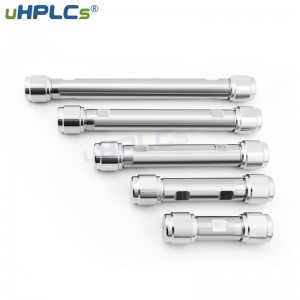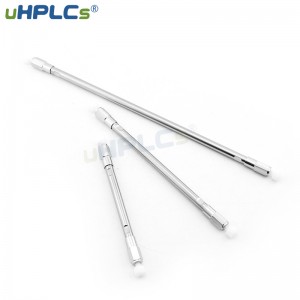The amino column is a liquid chromatographic column used in normal and reversed-phase conditions. However, normal-phase solvents and reverse-phase solvents are immiscible and cannot be ignored.
For newly purchased HPLC columns, first of all, please pay attention to opening the analysis and test instructions to understand the storage solvent of the column. If the storage solvent is not compatible with the polarity of the mobile phase, you will be using it. Please use isopropanol to transition first. During the transition process, pay attention to the fact that due to the high viscosity of isopropanol, the column pressure will be high, and the flow rate should be appropriately reduced.
If there are buffer salts in the mobile phase, first use the same proportion of the mobile phase without buffer salts to transition to avoid the precipitation of buffer salts.

01 Column efficiency test
Generally, one of the indicators to judge whether a user has experience is whether the user is used to preparing some standard solutions for column efficiency detection.
When it comes to column efficiency detection, we can provide you with a method it is very versatile. You can also use the same standard solution and mobile phase to detect silica gel, amino, and cyano columns.
Mobile phase: 10% ethyl acetate + 90% n-hexane flow rate 1.0
Standard solution: ethylbenzene (or toluene) + methyl benzoate
Detection wavelength 254nm
This method is especially suitable for detecting newly purchased columns (newly purchased columns are often stored in normal-phase solvents). If there is any problem, you can promptly communicate with the supplier. It is also suitable for the column to be fully cleaned and tested as a record before it is ready to be placed for a long period.
In normal use, if the analyte is fixed and repeated, we can, of course, make a judgment from the separation and analysis of the analyte. Still, if the analyte and the analysis conditions are different, regular detection of column efficiency can avoid declining column efficiency. It is a waste of human and material resources to analyze and determine the reason for poor separation.
It should be noted that when the amino column (or cyano column) is used in reversed-phase conditions, if this condition is used for detection, please pay attention to the phase change transition of the mobile phase.
02 Use of amino column
The aminopropyl group, the functional bonding group of the amino column, is easier to hydrolyze than the functional bonding groups C18, and C8 of the C18, and C8 column, so first of all, it is necessary to prepare psychologically for its shorter service life, especially when the use condition is reversed-phase…
Special attention should be paid to controlling the pH range when using reversed-phase conditions. The lower the pH value, the greater the risk of hydrolysis. The higher the proportion of water in the mobile phase, the greater the risk of hydrolysis.
Therefore, cleaning and storage of amino columns in pure organic solvents are necessary after use and when preparing to store for a long time.
When using an amino column for the analysis of acidic substances such as sugar in fruit juice, the presence of acidic substances means the presence of protons, which may protonate the slightly negatively charged amino functional groups and retain certain types of analytes after a period of use Changes in properties or a decrease in column efficiency.
It is recommended to wash the column with 5-10 times the column volume of 50-50 acetonitrile-water solution containing 0.5-1.0% NH3 (after washing, of course, use an alkali-free mobile phase to wash away excess ammonia). Then When analyzing such acidic analytes, it is recommended to add a small amount of ammonia, such as 0.1%, to the mobile phase.

03 Cleaning of amino column
To put it simply, the amino column used under normal phase conditions refers to the cleaning method of the silica gel column; the amino column used under reversed phase conditions refers to the cleaning method of C18.
(1) Usually used under normal phase conditions:
First, wash with 50 times the column volume of isopropanol. Due to the high viscosity of isopropanol, the flow rate needs to be lowered appropriately; after that, wash with 50 times the volume of methanol; after that, use isopropanol to transition back to the usual normal phase mobile phase you can.
(2) Usually used under reversed phase conditions:
The buffered salt should be washed in time, and the buffer salt cannot be washed directly with pure methanol. It is common sense, and no particular explanation will be made.
Rinse with 50 times pure methanol; then, after the transition with isopropanol, rinse the column with dichloromethane; then, transition back to methanol conditions with isopropanol.
These cleaning methods are mainly aimed at the processing methods when impurities in the sample are gradually adsorbed and accumulated on the filler. The behaviour of the chromatographic column is such as the increase of the column pressure and the decrease of the column efficiency.
04 Storage of amino column
How to use amino column:
1. The amino column can be used in both the normal phase and reverse phase, but it should be noted that the normal phase solvent and the reverse phase solvent are immiscible. Under normal circumstances, the new amino column is stored in a normal phase environment, such as amino column storage In n-hexane-acetonitrile (99:1).
2. Use in the positive phase
2.1 The mobile phase can be directly used for the new column. It is recommended to use n-hexane-acetonitrile (99:1) to flush 10 times the column volume at a flow rate of 0.5ml/min, then choose chloroform or methylene chloride with similar polarity to flush 10 times the column volume at the same flow rate according to the mobile phase, and finally Change to the mobile phase.
2.2 When used in the normal phase, it is not suitable to analyze compounds containing aldehyde groups and carbonyl groups and cannot be used for the analysis of reducing sugars; the mobile phase should be completely degassed and must not contain carbonyl compounds and peroxides (poor quality ether and tetrahydrofuran contain a small amount of ).
2.3 Whenever changing the mobile phase, make sure that the new mobile phase is miscible with the original storage solution of the column.
3 Use in reverse
3.1 First, use n-hexane-acetonitrile (99:1) to flush 10 times the column volume at a flow rate of 0.5ml/min, and then use chloroform, isopropanol, methanol, methanol-water (50:50 ) punch the pillar.
3.2 Rinse the column with 30 times the column volume of pH 11.0 sodium hydroxide aqueous solution at a flow rate of 0.5ml/min (note that the pH value must not exceed 11.0), and immediately rinse with water (0.5ml/min flow rate, 30 times column volume), and then changed to the mobile phase.
3.3 When preparing the mobile phase, each component should be measured separately, the components with a small proportion should be measured precisely, and the pH value should be adjusted to 0.1.
3.4 When used under reversed-phase conditions, special attention should be paid to controlling the pH range. The lower the pH value, the greater the risk of hydrolysis. The higher the proportion of water in the mobile phase, the greater the risk of hydrolysis. The ideal pH range is pH 3.0-7.0
3.5 The mobile phase to be used contains buffer salts. Before using the mobile analytical phase, use the same proportion of the mobile phase without buffer salts to transition to avoid the precipitation of buffer salts in the analytical column.
3.6 When an amino column is used for the analysis of acidic substances, the presence of acidic substances means the presence of protons, which may protonate the slightly negatively charged amino functional groups, resulting in the retention of properties for certain types of analytes after a period of use Changes or decreased column efficiency. It is recommended to wash the column with 5-10 times the column volume of acetonitrile-water (50:50) solution containing 0.5-1.0% NH3 (after washing, of course, use an alkali-free mobile phase to wash away excess ammonia). Then For the analysis of such acidic analytes, it is recommended to add a small amount of ammonia, such as 0.1%, to the mobile phase.
4 Washing of the liquid chromatographic column: To put it simply, the amino column used under normal phase conditions should refer to the cleaning method of the silica gel column; the amino column used under reversed phase conditions should refer to the cleaning method of C18.
5 Storage of liquid chromatographic columns
5.1 When using the normal phase, wash the column and store it with n-hexane-acetonitrile (99:1).
5.2 When used in the reverse phase, if it is not used for a short time, it can be stored with methanol or acetonitrile; if it is not used for a long time, the methanol should be replaced with isopropanol, chloroform, and finally stored with n-hexane.
6 Regeneration of the HPLC column
6.1 Scheme 1: Wash the column with methanol, isopropanol, chloroform, n-hexane, chloroform, isopropanol, and methanol in sequence (each at a flow rate of 0.5ml/min, 20 times the column volume), and then change the mobile phase. These cleaning methods are mainly aimed at the processing methods when impurities in the sample are gradually adsorbed and accumulated on the filler. The behavior of the chromatographic column is such as the increase of the column pressure and the decrease of the column efficiency.
6.2 Scheme 2: When the NH2 column is used in reversed-phase conditions, the NH2 bond will be hydrolyzed, especially outside the pH range of the column, and the column life will decrease rapidly under extremely acidic and alkaline conditions. If it is used under this condition, it needs to be cleaned. It needs to be washed with 10 times column volume solution for a while: 95% water/5% acetonitrile→THF tetrahydrofuran→95% acetonitrile/5% water→and keep 95% acetonitrile/5% water to continue washing, at a low flow rate of 0.2-0.5 mL/min rinse overnight.
6.3 Scheme 3: After the column has been used for a certain period, the column efficiency will decrease, and the column will be aged. You can also wash the column to restore the column performance. When cleaning, wash with the following solutions of 10 times the column volume: 95% water/5% acetonitrile → THF tetrahydrofuran → 95 % acetonitrile/5% water, and then the mobile phase.
The above methods are for reference only. Each brand of the chromatographic column has its characteristics; please refer to the official instructions for the liquid chromatographic column!
Post time: Feb-21-2023






